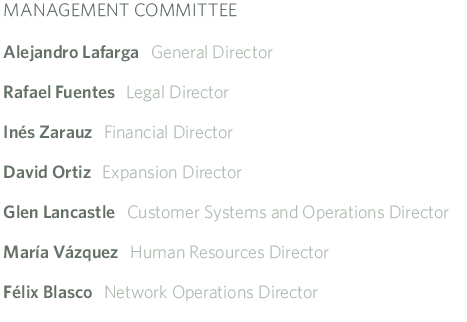2.1 Key Figures (data as of 31 december 2020)
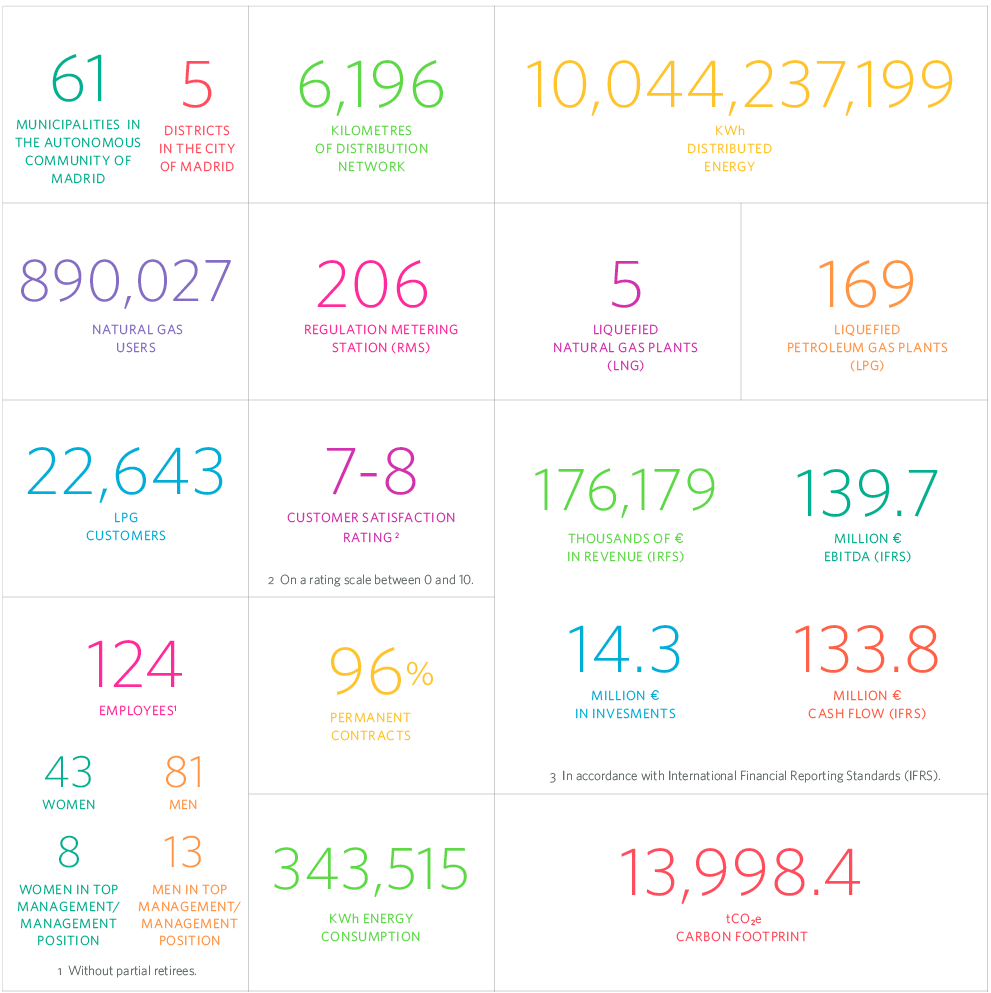
2.2 About Us
Madrileña Red de Gas S.A., MRG, is a sole proprietorship dedicated to the distribution of natural gas, as well as the distribution and sale of piped liquefied petroleum gases, so our main activity is classified as CNAE 3522, distribution by pipeline of gaseous fuels.
We are the first company on the Iberian Peninsula to operate a distribution network completely independently from the rest of the businesses in the natural gas value chain, resulting in the complete separation of networks and commercialisation of the Iberian energy market.
All our activity takes place in Spanish territory, specifically in the Autonomous Community of Madrid (CAM). We started the activity on 1 May 2010 in 38 municipalities. We currently distribute gas in 61 municipalities in the Autonomous Community, including the municipality of Madrid, where we operate in 5 districts. Our central offices are located in Virgilio Street, nº 2, in the town of Pozuelo de Alarcón.
MRG is the third largest gas distribution company in Spain by number of supply points. On 31 December 2020, we have 912,670 supply points.
We are currently working on a daily basis with a strong commitment to innovative projects together with companies and associations in the sector such as SEDIGAS (to which we belong), looking for transformative processes that increase the energy efficiency of end consumers and especially the future use of renewable energies. We are committed to the development of renewable gases such as hydrogen and biomethane.
2.3 Our Business
As we have already mentioned, Madrileña Red de Gas S.A., MRG, is a company dedicated to the distribution of natural gas, as well as the distribution and sale of liquefied petroleum gases through pipelines.

The arrival of natural gas in a municipality is an important step forward and a great boost to its economic activity. In companies and businesses, its use favours competitiveness and efficiency, which translates into energy savings of between 30% and 50% that can be used to increase the productivity of the business or company in any sector. For thousands of households, it means an improvement in the quality of life, as well as a significant saving in their energy bill, between 20% and 45%, depending on the consumption and the fuel replaced.
Within the objectives set by MRG, one of our priorities is to bring natural gas to all those municipalities that still do not have this energy source. Installing gas will help the economic and social development of the area.
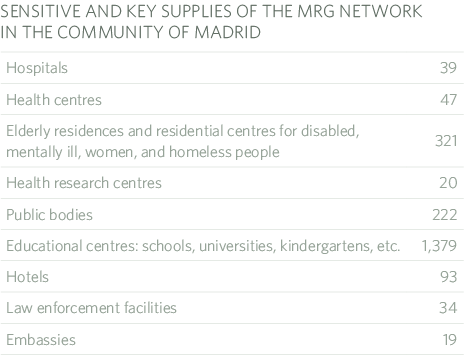
In addition, it should be taken into account that natural gas traditionally means bringing cleaner energy closer to the supply points due to its low emissions of NOX and CO2 particles. Furthermore, as detailed in Chapter 4.2, we are rising to the challenge of energy transformation towards cleaner and renewable gases.
The mass consumer market is becoming increasingly important for MRG. The specialization of the team by market has promoted more effective sales work to meet the different needs of the clients according to their profile.
Despite the severity with which the pandemic has affected this market, consumption has increased by more than 214 GWh, confirming the importance of natural gas in the sector. Among the results obtained, this year we can highlight the supply of gas to the Navalcarnero penitentiary centre and to two large industries that have used gas, orienting their energy transition process towards cleaner energies that also increase their energy efficiency.
In the LPG plant market, Madrileña has 169 satellite plants for those municipalities and residential areas where there is no distribution network. For yet another year we have continued our plan to convert LPG points to Natural Gas as a sign of our commitment to the goal of reducing emissions. During 2020, despite periods of downtime caused by the lockdown, we converted 700 homes to natural gas from a total of 27 piped propane installations.
In the area of new piped propane gas networks, in 2020 a commercial agreement was signed for the transfer of 61 new LPG supply points in the municipality of Los Molinos, including more than 3,000 metres of network and more than 60 connections. As part of this agreement, a commercial collaboration was signed for the transformation of more than 300 new supply points within the MRG distribution area.
MRG has a commercial network to attract new supply points. This pandemic year, the increase of new points in the residential market has clearly been affected by home quarantines and the caution of clients about face-to-face visits. In order to solve the problem, a telemarketing pilot project was set up by hiring an external company.
- We implement digital tools to optimize our service.
- This year 2020, despite the pandemic, has seen the further development of the project of virtual office for our customers.
- In addition, MRG has reinforced the use of WhatsApp as a priority channel of communication with its customers, given its popularity. Now the customer can carry out 90% of their transactions or requests for information through this channel.
- We have also upgraded our customer and user support call centre with a SaaS cloud solution from Amazon Connectt.
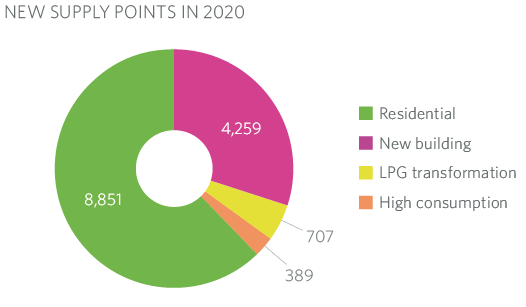

New construction
We work together with developers to bring the network to new buildings. Despite the uncertainties of the pandemic, in 2020 we have carried out 4,259 gas installations in new housing (33% more than planned), in addition to 32 centralised boiler rooms (2,800 homes with domestic hot water and heating). And we have signed four collaboration agreements for third party networks in 1,151 potential homes.
As detailed in point 4.2., we are working on a very innovative project concerning new urban developments capable of providing domestic hot water, heating, cooling and even lighting.
2.4 Corporate Governance
102-31102-33102-37

With regard to our corporate structure, Madrileña Red de Gas, SAU, is wholly owned by Elisandra Spain V, S.L., which in turn is owned by Elisandra Spain IV, S.L.
Elisandra Spain IV, S.L. has 4 foreign shareholders with different percentages of shares or voting rights.
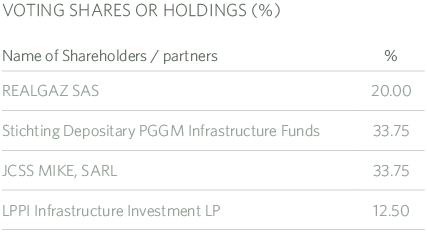
The governance structure is made up of the Board of Directors, the Audit and Risk Committee, the Remuneration Committee, with representation in all of them from the four partners of Elisandra Spain IV, S.L., and the Management Committee. In addition to these elements that constitute the highest governing body, there is a set of committees and commissions, of which members of the Board of Directors form part, which provide technical support to the responsibilities of governance.

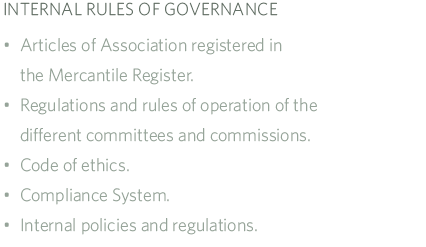
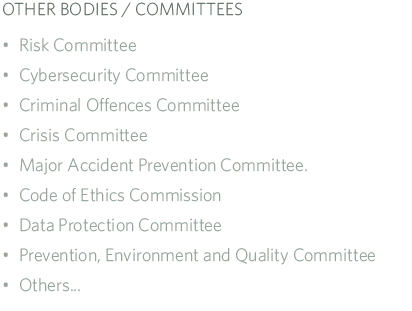
The Board of Directors is the form of administrative body established in the Articles of Association registered in the Mercantile Register and acts as a collegiate body. Its members, individually, are all non-executive proprietary directors, as opposed to the Management Committee, which includes executive members. The Articles of Association establish the rules for its functioning, the appointment of new members and the duration of positions, in accordance with the Spanish Capital Companies Act. In summary, the members of the Board are proposed by the Board of Directors itself and their appointment is accepted by the sole shareholder, in accordance with the provisions of the law. There are no independent members and the term of office is 6 years.
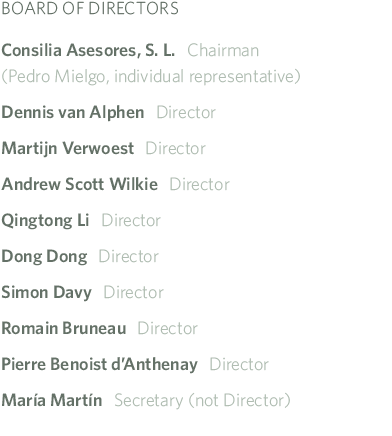
It is a collegiate body, so there are no significant positions beyond the existence of a Chairman of the Board, and it is governed by the Articles of Association and by the commitments, rights and obligations established in the Capital Companies Act.
The Board of Directors has not delegated its executive powers to any of its members. Its resolutions are executed by the General Manager of the Company, the only person with general management, administrative and decision-making powers.
Board members, upon detecting a conflict of interest must inform the Board of Directors and the Company itself. This communication is documented and included in the Company’s annual report. Likewise, as established in the Capital Companies Act, for those cases in which a possible conflict of interest is foreseen in the future, Article 230 of the same legal text establishes the exemption procedure for exceptional cases, which will be carried out, depending on the case, by the Board itself or, in this case, by the sole shareholder.
As the highest governance body, it defines the Company’s overall strategy and validates the management guidelines, as well as auditing the results.
The Mission, Vision, Values statements are defined by the company’s Management Committee and communicated to the Board of Directors, which approves them.
Likewise, the policies, strategies and objectives related to economic, environmental and social issues are defined by the Management Committee, and reported to the Board of Directors for approval, as part of management.
The Board of Directors meets at least every quarter. In the meeting, the Management Committee presents the results of the period, and updates are given on strategies, the progress of activities, economic, environmental and social issues of relevance to the organization and, at the request of the members, detailed information is provided on all those issues that they consider relevant. In addition, it may meet in extraordinary session if necessary.
The evaluation of the performance of the highest governance body is carried out through the annual accounts audit at year-end, which in compliance with the Non-Financial Information and Diversity Act 11/2018, provides non-financial information verifiable by an independent third party.
MRG has added in this ESG performance evaluation process its participation for the fifth consecutive year in the GRESB initiative by providing its ESG information, obtaining a score of 48 points. An analysis of these results has been carried out and a plan has been defined to improve this score.
The Board of Directors is a non-remunerated body, as established in the Company’s Articles of Association. Stakeholder involvement in the remuneration of senior executives is carried out through the Remuneration Committee.
Two Committees have been established within the Board of Directors, with specific tasks, on which they report to the Board.
The Audit and Risk Committee
The Audit and Risk Committee oversees MRG’s risk, audit and compliance functions. It is made up of representatives of the Board of Directors, the Management Committee and the risk management department. It reports directly to the Board of Directors and operates in accordance with the internal regulations, which define its objectives, functions and composition. Its main functions are:
- Financial audit: supervision of the processes of auditor selection, audit plan, evolution of the audit process and results of the final report. Evaluation of financial statements and annual accounts.
- Corporate risk map: overall monitoring of the evolution of the main risks and associated mitigation plans. Awareness of the results of audit reports linked to key risks and proposals for improvement (e.g. cybersecurity, health and safety, environment, major accident prevention).
- Sustainability/u>: policy and performance monitoring.
- Existing insurance policy for various risks: definition and monitoring.
- Compliance System: Overseeing the performance of the criminal offence prevention function carried out by the Crime Prevention Committee (CPC) and the Criminal Compliance Officer.
Where appropriate, it issues recommendations and proposals for improvement to the Board of Directors and the rest of the management bodies on the different issues within its sphere of competence.
The Audit and Risk Committee meets quarterly unless otherwise directed by the Board. In practice, it always meets before each meeting of the Board of Directors. At the beginning of each year, a consensus is reached on the agenda of topics to be dealt with.
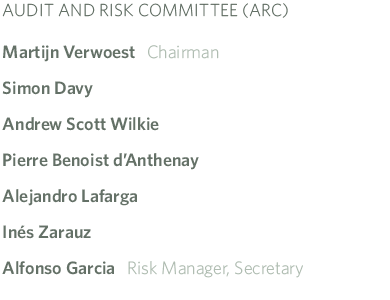
The Remuneration Committee
The Remuneration Committee shall determine and recommend to the Board of Directors the general remuneration framework and policy and any variations to the terms and conditions of service of the CEO, Chief Financial Officer and any other members of management as may be appropriate to consider or other employees. It is responsible for all elements of remuneration for MRG Unit Managers, i.e., basic salary, bonuses, benefits, pension scheme.
It has the obligation to agree at a generic level on the principles and structure of the remuneration proposal for all MRG members not under CBA (Collective Bargaining Agreement), to plan how to attract, retain and develop talent together with the CEO, to establish succession plans and their review.
The Committee’s proposals are forwarded to the Board of Directors. The Committee meets at least once or twice a year, although it may increase the frequency when it deems it necessary.
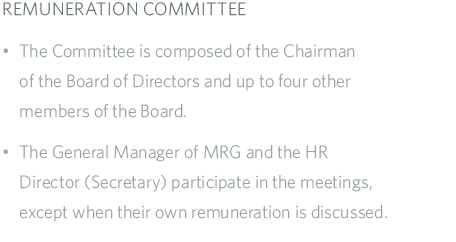
The Management Committee
The Management Committee is a body comprising the General Manager or CEO of the Company and the heads of the six Unit Divisions. The Unit Directors report to the Committee on the operational and management proposals they consider appropriate or necessary for their respective Units. The executive decisions of the Management Committee are adopted by the Company’s General Manager or CEO.
Its main functions are:
- Definition of policies, strategies and objectives, which are transmitted to the General Management, in order to comply with the Company’s strategic plan, and monitoring of the same.
- Monitoring the general performance and specific projects of the Company’s operational and business areas: expansion, customer operations and network operations.
- Overall monitoring of compliance with financial performance targets.
- Identification of risks and opportunities. Definition of risk mitigation policies and plans, as well as their follow-up.
- Definition by the General Management of the performance objectives by processes and supervision of the evolution of the Company’s scorecard of management indicators. Proposal and implementation of improvement actions.
- Monitoring of the various corporate issues with cross-cutting implications that are considered relevant (regulation and legal compliance, sustainability, human resources, health and safety, environment, personal data protection, prevention of criminal offences, etc.).
The objectives and operating procedures of the technical committees and commissions identified in this chapter are listed throughout the report, according to their area of work or scope.
